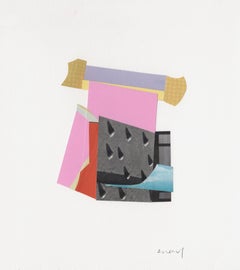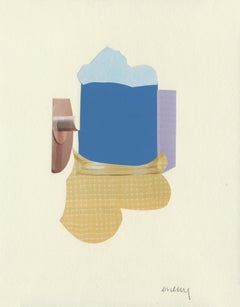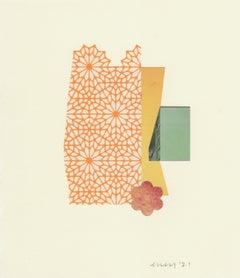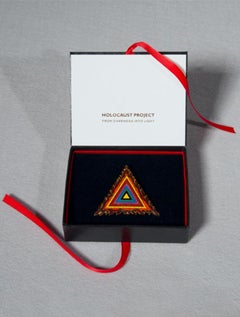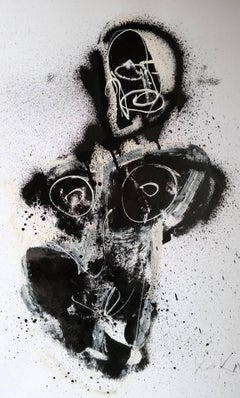Elizabeth Emery Art
American, b. 1964
Elizabeth Emery is a multidisciplinary artist working in various mediums and across genres. Her sculptures and paintings reference movement, gravity, and the experience of the body in chaotic surroundings. Her work has been exhibited at museums and galleries across the United States including Museum of Modern Art Cleveland, Hammond Harkins Gallery, and Bunnell Arts Gallery in Alaska. She has also developed several series of silkscreen monoprint collage drawings for public commissions in hospitals and a library. Her work has been supported by the Ohio Arts Council, Rasmuson Foundation, and New York Foundation for the Arts, among others. Emery has been awarded residencies at Haystack, Jentel Foundation, Rasmuson Foundation, and FRONT International. Her work is in collections including at The Cleveland Clinic, Progressive Insurance, American Greetings, Rockefeller Collection, Westin Hotel Cleveland, and Schein-Joseph International Museum of Ceramic Art. As an extension of her creative work and a former professional athlete, Emery operates the podcast, Hear Her Sports, which invites conversation around women’s sports. Through interviews, advocacy, and writing she celebrates individual female athletes who represent a range of backgrounds, perspectives and issues. A special edition of Hear Her Sports was recently commissioned as part of FRONT International: Cleveland Triennial for Contemporary Art. This collection of audio stories was originally presented by the Cleveland YWCA and is now housed in the Sports Research Center at Cleveland Public Library. Emery holds an MFA in ceramic sculpture from Alfred University. She now lives in Cleveland where her studio is inside a foreclosed house. Whatever her medium -- sound, ceramic, or collage -- Elizabeth Emery responds to the world with creativity, passion, and a desire to connect and make things better.(Biography provided by TurningArt)
to
14
8
3
3
11
3
Overall Height
to
Overall Width
to
3
14
14
6,909
3,240
2,514
1,217
14
9
5
1
1
Artist: Elizabeth Emery
Chair, Original Mixed Media Collage, 2021
By Elizabeth Emery
Located in Boston, MA
Chair, Original Mixed Media Collage, 2021
Artist Commentary:
This is one of months of daily collages made in prep for a multiple piece commission...
Category
21st Century and Contemporary Elizabeth Emery Art
Materials
Paper, Mixed Media
Lobby Arc, Abstract Mixed Media Collage on Paper, 2020
By Elizabeth Emery
Located in Boston, MA
Lobby Arc, Abstract Mixed Media Collage on Paper, 2020
7" x 6" (HxW), hand-signed in the lower right-hand corner
This small format mixed media collage combines hand cut paper and fo...
Category
21st Century and Contemporary Abstract Elizabeth Emery Art
Materials
Foil
Pink Balance, Abstract Mixed Media Collage on Paper, 2021
By Elizabeth Emery
Located in Boston, MA
Pink Balance, Abstract Mixed Media Collage on Paper, 2021
7" x 7" (HxW), hand-signed by the artist
This collage features layers of cut paper featuring both flat colors of pink, purp...
Category
21st Century and Contemporary Abstract Geometric Elizabeth Emery Art
Materials
Paper, Mixed Media
Blue Couch, Original Mixed Media Collage, 2021
By Elizabeth Emery
Located in Boston, MA
Blue Couch, Original Mixed Media Collage, 2021
Artist Commentary:
This is one of months of daily collages made in prep for a multiple piece commissioned series.
Keywords: hand cut,...
Category
21st Century and Contemporary Elizabeth Emery Art
Materials
Paper, Mixed Media
Sandstar, Abstract Mixed Media Collage on Paper, 2021
By Elizabeth Emery
Located in Boston, MA
Sandstar, Abstract Mixed Media Collage on Paper, 2021
4.5" x 6.35" (HxW)
This abstract collage combines a variation of visual elements in...
Category
21st Century and Contemporary Abstract Elizabeth Emery Art
Materials
Paper, Mixed Media
Wanderings (Window) Oct21, Abstract Monoprint on Paper, 2021
By Elizabeth Emery
Located in Boston, MA
Artist Commentary:
Since completing a large scale long-term commission, I've been having fun in the studio and reacquainting myself with color, landscape, fun collage materials. The ...
Category
21st Century and Contemporary Elizabeth Emery Art
Materials
Paper, Mixed Media
Wanderings (Reading) Oct21
By Elizabeth Emery
Located in Boston, MA
Artist Commentary:
Since completing a large scale long-term commission, I've been having fun in the studio and reacquainting myself with color, landscape, fun collage materials. The ...
Category
21st Century and Contemporary Elizabeth Emery Art
Materials
Paper, Mixed Media
Wanderings (Rain) Oct21
By Elizabeth Emery
Located in Boston, MA
Artist Commentary:
Since completing a large scale long-term commission, I've been having fun in the studio and reacquainting myself with color, landscape, fun collage materials. The ...
Category
21st Century and Contemporary Elizabeth Emery Art
Materials
Paper, Mixed Media
Wanderings (Cloud) Oct21, Abstract Monoprint on Paper, 2021
By Elizabeth Emery
Located in Boston, MA
Artist Commentary:
Since completing a large scale long-term commission, I've been having fun in the studio and reacquainting myself with color, landscape, fun collage materials. The ...
Category
21st Century and Contemporary Elizabeth Emery Art
Materials
Paper, Mixed Media
Deer, Mixed Media Monoprint, 2020
By Elizabeth Emery
Located in Boston, MA
Artist Commentary:
What I really love about collage is the shapes and colors, by chance, connect with one another.
Keywords: hand cut, paper, abstract, collage, painting, tree, rose...
Category
21st Century and Contemporary Elizabeth Emery Art
Materials
Paper, Monoprint
If I Could Fly Vi, Abstract Monoprint on Paper, 2018
By Elizabeth Emery
Located in Boston, MA
Artist Commentary:
This silkscreen and collage is from a long-standing series of work about how structure and systems holds together chaos. One major inspiration is Matisse's cutouts...
Category
21st Century and Contemporary Elizabeth Emery Art
Materials
Paper, Monoprint
Ocean Dream Cloud, Abstract Monoprint on Paper, 2018
By Elizabeth Emery
Located in Boston, MA
Artist Commentary:
This silkscreen and collage is from a long-standing series of work about how structure and systems holds together chaos. One major inspiration is Matisse's cutouts...
Category
21st Century and Contemporary Elizabeth Emery Art
Materials
Paper, Monoprint
Tree Collage, Mixed Media Monoprint, 2020
By Elizabeth Emery
Located in Boston, MA
Artist Commentary:
What I really love about collage is the shapes and colors, by chance, connect with one another.
Keywords: hand cut, paper, abstract, collage, painting, tree, rose...
Category
21st Century and Contemporary Elizabeth Emery Art
Materials
Paper, Monoprint
If I Could Fly Iv, Mixed Media Monoprint, 2018
By Elizabeth Emery
Located in Boston, MA
Artist Commentary:
For these monoprint collages, I silkscreen patterns as a grounding structure for collage and drawing. This background of dots, hash marks, and tile patterns provid...
Category
21st Century and Contemporary Elizabeth Emery Art
Materials
Paper, Monoprint
Related Items
Holocaust Remembrance Logo Pin and Pendant
By Judy Chicago
Located in New York, NY
Judy Chicago
Logo Pin and Pendant, 1993
Enameled pin with pendant loop in original presentation box
2 1/2 × 2 1/2 × 1/5 inches
Judy Chicago's incised name and date on the verso
Comes in original presentation gift box
Poignant enameled Holocaust Project Logo pin & pendant based on the logo designed by Judy Chicago for the Holocaust Project: From Darkness into Light
More about pioneering artist Judy Chicago
Judy Chicago (born Judith Sylvia Cohen; July 20, 1939) is an American feminist artist, art educator, and writer known for her large collaborative art installation pieces about birth and creation images, which examine the role of women in history and culture. During the 1970s, Chicago founded the first feminist art program in the United States at California State University, Fresno (formerly Fresno State College) which acted as a catalyst for feminist art and art education during the 1970s. Her inclusion in hundreds of publications in various areas of the world showcases her influence in the worldwide art community. Additionally, many of her books have been published in other countries, making her work more accessible to international readers. Chicago's work incorporates a variety of artistic skills, such as needlework, counterbalanced with skills such as welding and pyrotechnics. Chicago's most well known work is The Dinner Party, which is permanently installed in the Elizabeth A. Sackler Center for Feminist Art at the Brooklyn Museum. The Dinner Party celebrates the accomplishments of women throughout history and is widely regarded as the first epic feminist artwork. Other notable art projects by Chicago include International Honor Quilt, Birth Project, Powerplay, and The Holocaust Project. She is represented by Jessica Silverman...
Category
1990s Abstract Geometric Elizabeth Emery Art
Materials
Metal, Enamel
Black Chola
By Kokian
Located in Saint Ouen, FR
Beautiful drawing by Kokian - from his more graphic and refined series.
Mixed Technique on Art Paper
Title and signature by the artist
Dimensions 65 x 50 cm
Carefully sent with the a...
Category
Early 2000s Elizabeth Emery Art
Materials
Paper, Mixed Media
Moment of Reflections 1
Located in Ibadan, Oyo
In "Moment of Reflections," Olatunbosun transports the audience into a world of contemplation and self-discovery. The centerpiece of the artwork is a young man seated in a casual, relaxed manner. His pose conveys a sense of tranquility as if he has found solace in the moments of quiet contemplation. The attention to detail in the artwork is striking, with intricate brushwork bringing out the textures of the subject's clothing and the surrounding environment.
The setting of the artwork is deliberately minimalistic, allowing the viewer to focus entirely on the young man's expression and demeanor. The background is a subtle blend of soft colors, suggesting an ethereal space where thoughts roam freely. This simplicity further accentuates the theme of reflection, as the absence of distractions allows viewers to immerse themselves in their own thoughts while contemplating the emotions conveyed by the subject.
Olatunbosun's "Moment of Reflections" is a remarkable piece that resonates deeply with viewers from all walks of life. The young man's expression exudes a sense of inner peace, prompting viewers to ponder their own life experiences and contemplate the paths they have taken. This introspective quality of the artwork creates an intimate connection between the audience and the subject, allowing for a deeply personal and emotional experience.
The painting's title, "Moment of Reflections," is deliberately chosen to reinforce the idea of taking a moment for self-exploration and soul-searching. In the hustle and bustle of modern life, we often overlook the importance of pausing and reflecting on our journey. Olatunbosun's artwork serves as a gentle reminder to find time for introspection and to appreciate the beauty in moments of quietude.
What makes "Moment of Reflections" even more extraordinary is its ability to transcend cultural boundaries. The emotions depicted in the artwork are universal, touching the core of human experiences. Whether the viewer is from the artist's homeland or halfway across the world, the profound message remains relevant – we all share moments of contemplation and self-discovery in our lives.
In conclusion, Samson Olatunbosun's "Moment of Reflections" is a timeless masterpiece that captures the human spirit with its simplicity and emotional depth. Through his brilliant artistic skill, Olatunbosun creates an atmosphere of introspection, inviting viewers to engage in their own moments of contemplation and self-discovery. This extraordinary artwork serves as a poignant reminder of the power of art to connect us all through our shared humanity and emotions. As we gaze upon the young man seated in a relaxed manner, we are reminded to embrace the beauty of silence, to reflect on our past, and to seek meaning in the present – a truly profound and impactful journey offered by the artistic genius of Samson Olatunbosun.
Shipping Procedure
Ships in a well-protected tube from Nigeria
This work is unique, not a print or other type of copy.
Accompanied by a Certificate of Authenticity (Issued by the Gallery)
About Artist
Samson Olatubosun...
Category
19th Century Modern Elizabeth Emery Art
Materials
Mixed Media, Photographic Paper, Acrylic, Oil, Canvas
Moment of Reflections 2
Located in Ibadan, Oyo
In "Moment of Reflections," Olatunbosun transports the audience into a world of contemplation and self-discovery. The centerpiece of the artwork is a young man seated in a casual, relaxed manner. His pose conveys a sense of tranquility as if he has found solace in the moments of quiet contemplation. The attention to detail in the artwork is striking, with intricate brushwork bringing out the textures of the subject's clothing and the surrounding environment.
The setting of the artwork is deliberately minimalistic, allowing the viewer to focus entirely on the young man's expression and demeanor. The background is a subtle blend of soft colors, suggesting an ethereal space where thoughts roam freely. This simplicity further accentuates the theme of reflection, as the absence of distractions allows viewers to immerse themselves in their own thoughts while contemplating the emotions conveyed by the subject.
Olatunbosun's "Moment of Reflections" is a remarkable piece that resonates deeply with viewers from all walks of life. The young man's expression exudes a sense of inner peace, prompting viewers to ponder their own life experiences and contemplate the paths they have taken. This introspective quality of the artwork creates an intimate connection between the audience and the subject, allowing for a deeply personal and emotional experience.
The painting's title, "Moment of Reflections," is deliberately chosen to reinforce the idea of taking a moment for self-exploration and soul-searching. In the hustle and bustle of modern life, we often overlook the importance of pausing and reflecting on our journey. Olatunbosun's artwork serves as a gentle reminder to find time for introspection and to appreciate the beauty in moments of quietude.
What makes "Moment of Reflections" even more extraordinary is its ability to transcend cultural boundaries. The emotions depicted in the artwork are universal, touching the core of human experiences. Whether the viewer is from the artist's homeland or halfway across the world, the profound message remains relevant – we all share moments of contemplation and self-discovery in our lives.
In conclusion, Samson Olatunbosun's "Moment of Reflections" is a timeless masterpiece that captures the human spirit with its simplicity and emotional depth. Through his brilliant artistic skill, Olatunbosun creates an atmosphere of introspection, inviting viewers to engage in their own moments of contemplation and self-discovery. This extraordinary artwork serves as a poignant reminder of the power of art to connect us all through our shared humanity and emotions. As we gaze upon the young man seated in a relaxed manner, we are reminded to embrace the beauty of silence, to reflect on our past, and to seek meaning in the present – a truly profound and impactful journey offered by the artistic genius of Samson Olatunbosun.
Shipping Procedure
Ships in a well-protected tube from Nigeria
This work is unique, not a print or other type of copy.
Accompanied by a Certificate of Authenticity (Issued by the Gallery)
About Artist
Samson Olatubosun...
Category
19th Century Modern Elizabeth Emery Art
Materials
Canvas, Mixed Media, Oil, Acrylic, Photographic Paper
Organic Lilac Flower, Organic Painting Style, Pastel Purple, Abstract Background
Located in Barcelona, ES
This is an exclusive handmade mixed media cyanotype with hand-painted acrylic paint in pastel tones.
Details:
Title: Lilac Leaf on Water
Medium: Mixed Media on Watercolor Paper
Size: 100x70 cm
Year: 2020
*Frame is for illustrative purposes only, artwork is shipped carefully rolled in a tube.
WHAT IS A CYANOTYPE?
The cyanotype (a.k.a. sun-print) process is one of the oldest in the history of photography, dating back to the 1840's.
Cyanotypes were then made famous by Anna Atkins...
Category
2010s Abstract Elizabeth Emery Art
Materials
Archival Ink, Mixed Media, Oil, Acrylic, Watercolor, Archival Paper
Angel Descending the Staircase, Acrylic Pastel Abstract Painting, Framed
By a.muse
Located in New york, NY
Angel Descending the Staircase, 2019 by a.muse is a 15” x 11” x 3/16” acrylic and pastel stick collage on canvas mounted on board. The painting is signed (on front and back), titled,...
Category
2010s Abstract Elizabeth Emery Art
Materials
Mixed Media, Acrylic, Archival Paper
Homage a Sam Francis, Folded Monoprint Mixed Media Splatter Painting Art Print
By Richard Royce
Located in Surfside, FL
This is a mixed media monoprint titled Homage a Sam (I first thought it was for Sam Gilliam but the artist told me it was for Sam Francis. He has done a number of these Homages as I ...
Category
1980s Abstract Expressionist Elizabeth Emery Art
Materials
Mixed Media, Handmade Paper, Monoprint
1950s Abstract Composition in Brown, Orange and Blue with Black Parallel Lines
By Herbert Bayer
Located in Denver, CO
Watercolor and ink on paper of an abstract composition of brown, orange and blue shapes between black parallel lines throughout the the piece by Herbert Bayer (1900-1985). Presented in a custom black frame with all archival materials. Framed dimensions measure 17 ⅞ x 22 ⅝ x 1 inches. Image size is 10 ¼ x 15 ½ inches.
Painting is clean and in very good condition - please contact us for a detailed condition report.
Expedited and international shipping is available - please contact us for a quote.
About the Artist:
Herbert Bayer enjoyed a versatile sixty-year career spanning Europe and America that included abstract and surrealist painting, sculpture, environmental art, industrial design, architecture, murals, graphic design, lithography, photography and tapestry. He was one of the few “total artists” of the twentieth century, producing works that “expressed the needs of an industrial age as well as mirroring the advanced tendencies of the avant-garde.”
One of four children of a tax revenue officer growing up in a village in the Austrian Salzkammergut Lake region, Bayer developed a love of nature and a life-long attachment to the mountains. A devotee of the Vienna Secession and the Vienna Workshops (Wiener Werkstätte) whose style influenced Bauhaus craftsmen in the 1920s, his dream of studying at the Academy of Art in Vienna was dashed at age seventeen by his father’s premature death.
In 1919 Bayer began an apprenticeship with architect and designer, Georg Schmidthamer, where he produced his first typographic works. Later that same year he moved to Darmstadt, Germany, to work at the Mathildenhöhe Artists’ Colony with architect Emanuel Josef Margold of the Viennese School. As his working apprentice, Bayer first learned about the design of packages – something entirely new at the time – as well as the design of interiors and graphics of a decorative expressionist style, all of which later figured in his professional career.
While at Darmstadt, he came across Wassily Kandinsky’s book, Concerning the Spiritual in Art, and learned of the new art school, the Weimar Bauhaus, in which he enrolled in 1921. He initially attended Johannes Itten’s preliminary course, followed by Wassily Kandinsky’s workshop on mural painting. Bayer later recalled, “The early years at the Bauhaus in Weimar became the formative experience of my subsequent work.” Following graduation in 1925, he was appointed head of the newly-created workshop for print and advertising at the Dessau Bauhaus that also produced the school’s own print works. During this time he designed the “Universal” typeface emphasizing legibility by removing the ornaments from letterforms (serifs).
Three years later he left the Bauhaus to focus more on his own artwork, moving to Berlin where he worked as a graphic designer in advertising and as an artistic director of the Dorland Studio advertising agency. (Forty years later he designed a vast traveling exhibition, catalog and poster -- 50 Jahre Bauhaus -- shown in Germany, South America, Japan, Canada and the United States.) In pre-World War II Berlin he also pursued the design of exhibitions, painting, photography and photomontage, and was art director of Vogue magazine in Paris. On account of his previous association with the Bauhaus, the German Nazis removed his paintings from German museums and included him among the artists in a large exhibition entitled Degenerate Art (Entartete Kunst) that toured German and Austrian museums in 1937.
His inclusion in that exhibition and the worsening political conditions in Nazi Germany prompted him to travel to New York that year with Marcel Breuer, meeting with former Bauhaus colleagues, Walter Gropius and László Moholy-Nagy to explore the possibilities of employment after immigration to the United States. In 1938 Bayer permanently relocated to the United States, settling in New York where he had a long and distinguished career in practically every aspect of the graphic arts, working for drug companies, magazines, department stores, and industrial corporations. In 1938 he arranged the exhibition, “Bauhaus 1919-1928” at the Museum of Modern Art, followed later by “Road to Victory” (1942, directed by Edward Steichen), “Airways to Peace” (1943) and “Art in Progress” (1944).
Bayer’s designs for “Modern Art in Advertising” (1945), an exhibition of the Container Corporation of America (CAA) at the Art Institute of Chicago, earned him the support and friendship of Walter Paepcke, the corporation’s president and chairman of the board. Paepcke, whose embrace of modern currents and design changed the look of American advertising and industry, hired him to move to Aspen, Colorado, in 1946 as a design consultant transforming the moribund mountain town into a ski resort and a cultural center. Over the next twenty-eight years he became an influential catalyst in the community as a painter, graphic designer, architect and landscape designer, also serving as a design consultant for the Aspen Cultural Center.
In the summer of 1949 Bayer promoted through poster design and other design work Paepcke’s Goethe Bicentennial Convocation attended by 2,000 visitors to Aspen and highlighted by the participation of Albert Schweitzer, Arthur Rubenstein, Jose Ortega y Gasset and Thornton Wilder. The celebration, held in a tent designed by Finnish architect Eero Saarinen, led to the establishment that same year of the world-famous Aspen Music Festival and School regarded as one of the top classical music venues in the United States, and the Aspen Institute for Humanistic Studies in (now the Aspen Institute), promoting in Paepcke’s words “the cross fertilization of men’s minds.”
In 1946 Bayer completed his first architecture design project in Aspen, the Sundeck Ski Restaurant, at an elevation of 11,300 feet on Ajax Mountain. Three years later he built his first studio on Red Mountain, followed by a home which he sold in 1953 to Robert O. Anderson, founder of the Atlantic Richfield Company who became very active in the Aspen Institute. Bayer later designed Anderson’s terrace home in Aspen (1962) and a private chapel for the Anderson family in Valley Hondo, New Mexico (1963).
Transplanting German Bauhaus design to the Colorado Rockies, Bayer created along with associate architect, Fredric Benedict, a series of buildings for the modern Aspen Institute complex: Koch Seminar Building (1952), Aspen Meadows guest chalets and Center Building (both 1954), Health Center and Aspen Meadows Restaurant (Copper Kettle, both 1955). For the grounds of the Aspen Institute in 1955 Bayer executed the Marble Garden and conceived the Grass Mound, the first recorded “earthwork” environment In 1973-74 he completed Anderson Park for the Institute, a continuation of his fascination with environmental earth art.
In 1961 he designed the Walter Paepcke Auditorium and Memorial Building, completing three years later his most ambitious and original design project – the Musical Festival Tent for the Music Associates of Aspen. (In 2000 the tent was replaced with a design by Harry Teague.) One of Bayer’s ambitious plans from the 1950s, unrealized due to Paepcke’s death in 1960, was an architectural village on the outskirts of the Aspen Institute, featuring seventeen of the world’s most notable architects – Walter Gropius, Marcel Breuer, I.M. Pei, Minoru Yamasaki, Edward Durrell Stone and Phillip Johnson – who accepted his offer to design and build houses.
Concurrent with Bayer’s design and consultant work while based in Aspen for almost thirty years, he continued painting, printmaking, and mural work. Shortly after relocating to Colorado, he further developed his “Mountains and Convolutions” series begun in Vermont in 1944, exploring nature’s fury and repose. Seeing mountains as “simplified forms reduced to sculptural surface in motion,” he executed in 1948 a series of seven two-color lithographs (edition of 90) for the Colorado Springs Fine Arts Center. Colorado’s multi-planal typography similarly inspired Verdure, a large mural commissioned by Walter Gropius for the Harkness Commons Building at Harvard University (1950), and a large exterior sgraffito mural for the Koch Seminar Building at the Aspen Institute (1953).
Having exhausted by that time the subject matter of “Mountains and Convulsions,” Bayer returned to geometric abstractions which he pursued over the next three decades. In 1954 he started the “Linear Structure” series containing a richly-colored balance format with bands of sticks of continuously modulated colors. That same year he did a small group of paintings, “Forces of Time,” expressionist abstractions exploring the temporal dimension of nature’s seasonal molting. He also debuted a “Moon and Structure” series in which constructed, architectural form served as the underpinning for the elaboration of color variations and transformations.
Geometric abstraction likewise appeared his free-standing metal sculpture, Kaleidoscreen (1957), a large experimental project for ALCOA (Aluminum Corporation of America) installed as an outdoor space divider on the Aspen Meadows in the Aspen Institute complex. Composed of seven prefabricated, multi-colored and textured panels, they could be turned ninety degrees to intersect and form a continuous plane in which the panels recomposed like pieces of a jigsaw puzzle. He similarly used prefabricated elements for Articulated Wall, a very tall free-standing sculpture commissioned for the Olympic Games in Mexico...
Category
1950s Abstract Geometric Elizabeth Emery Art
Materials
Paper, Ink, Mixed Media, Watercolor
H 17.75 in W 22.5 in D 1 in
Bicentennial Dawn
By Louise Nevelson
Located in New York, NY
Louise Nevelson
Bicentennial Dawn, 1976
Photolithograph, silkscreen and gold foil on white wove paper
hand signed, dated and numbered 15/100 with incised signature on the front
35 × ...
Category
1970s Abstract Elizabeth Emery Art
Materials
Foil
Intenciones del Silencio III. Mixed media on canvas
Located in Miami Beach, FL
Intenciones del Silencio III, 2019 by Angélica Chavarro Franco
From the series Intenciones del Silencio
Mixed media (Oil paint and textile) on canvas
Frame size: 14.9 H in x 16.9 W...
Category
2010s Abstract Elizabeth Emery Art
Materials
Textile, Canvas, Paper, Mixed Media, Oil
H 14.9 in W 16.9 in D 1.3 in
Landscape Transformed, Contemporary Abstract Tapestry, Textile Wall Sculpture
By Adela Akers
Located in Wilton, CT
Adela Akers (b. 1933, Santiago de Compostela, Spain) is a Spanish-born textile and fiber artist. She is Professor Emeritus (1972 to 1995) at the Tyler Scho...
Category
2010s Abstract Elizabeth Emery Art
Materials
Metal, Foil
Jerusalem, Mixed Media Abstract
By Amos M. Holbrook
Located in Surfside, FL
Holbrook creates an abstract cityscape of Jerusalem by overlaying geometric shapes with vivid colors that take the form of buildings, on top of a collaged background of Hebrew text.
Category
20th Century Abstract Geometric Elizabeth Emery Art
Materials
Canvas, Mixed Media
Elizabeth Emery art for sale on 1stDibs.
Find a wide variety of authentic Elizabeth Emery art available for sale on 1stDibs. You can also browse by medium to find art by Elizabeth Emery in paper, mixed media, monoprint and more. Much of the original work by this artist or collective was created during the 21st century and contemporary and is mostly associated with the abstract style. Not every interior allows for large Elizabeth Emery art, so small editions measuring 5 inches across are available. Elizabeth Emery art prices can differ depending upon medium, time period and other attributes. On 1stDibs, the price for these items starts at $225 and tops out at $1,250, while the average work can sell for $225.


